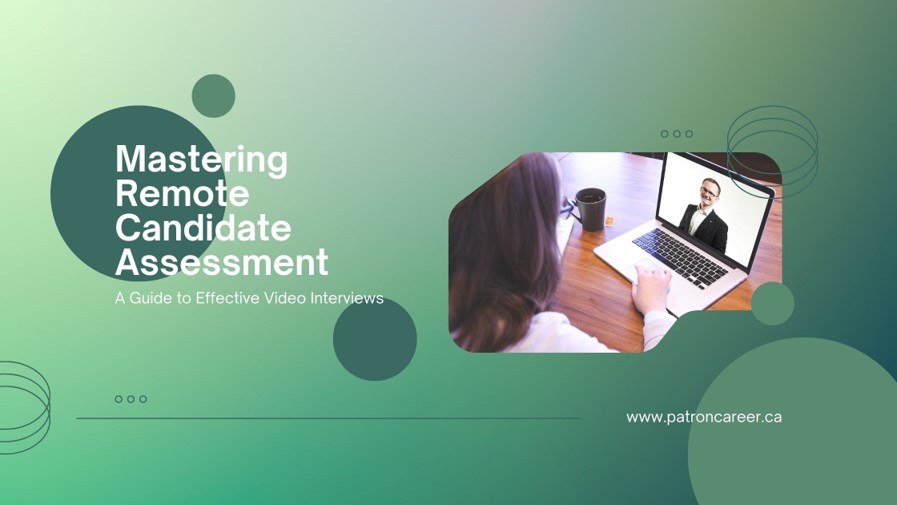
Transform Your Company Culture
06 September, 2023
Patron Career Staffing firmly believes in adopting a tailored approach to meet temporary and permanent recruitment needs. We safeguard the interest of our clients by finding such workers who are knowledgeable and reliable.
About UsNeed help? Make a Call
32 Dundas Street East Unit A, L5A1W2

Abstract- Learn how to excel in remote candidate assessment with our comprehensive guide on conducting effective video interviews. Discover the key steps to prepare, choose the right technology, and establish a strong rapport with candidates. We also delve into essential techniques for assessing qualifications and cultural fit. Avoid common mistakes, such as technical glitches and biases, to ensure a smooth and fair evaluation process. Embrace the power of video interviews to tap into a global talent pool and make informed hiring decisions regardless of geographical boundaries. Elevate your recruitment game with our expert insights and tips.
The age-old methods of recruitment and hiring have now gone obsolete owing to the recent developments in technology and hiring protocols, completely refurbishing how employers connect and assess potential candidates. Turning things around, video interviews are becoming increasingly popular, especially in the area of remote hiring. No matter the distance or difference in time zones, video technology has grabbed the attention of recruiters so much since its adoption during the COVID-19 pandemic.
This article will take you through what video interviews are, lay a detailed guide on conducting video interviews, illuminate common mistakes to avoid and share tips for successful remote candidate assessment.
What Are Video Interviews All About?
As the name itself suggests, video interviews are typically remote recruitment method which involves interaction through video conferencing between employers and candidates. The widely used platforms are Skype, Zoom, Google Meet, Microsoft Teams and so on. The didactic behind this assessment method is to do away with face-to-face interviews and bring on modern methods to streamline the hiring process and save time and resources. It enables management to capitalize on a broader talent pool.
A variety of video assessment tests are there in the market, ranging from live video interviews, and one-way/ two-way interviews to pre-recorded interviews wherein the candidate is asked to submit his video application. These categories have their advantages and disadvantages.
Mastering the Art of Conducting Effective Video Interviews

1. Choosing the right technology: Accessibility is the most vital factor to have a successful video interview session. That is, making the right choice of video conferring platform is required which both the hiring manager/ interviewer and the interviewee are comfortable with. The software you choose should have reliable connectivity, no disruptive glitches, sound video and audio quality and features such as screen sharing.
2. Preparing in advance: planning ahead of the interview flurry will save you from hubbub and gainsay. We pinpoint that preparation is key, similar to the traditional method of recruitment. Beforehand, figure out the psychometric , analytical, situational or behavioural questions based on the candidate's resume. The goals you set should be time-specific and clear. Abide by proper interview etiquette and maintain all legal employment guidelines even though it’s a video-based interview.
You may check out our interview guide for both interviews and job seekers, here.
3. Set the Stage: Find a quiet, well-lit space for the interview. Make sure your background is professional and free from distractions. Test your camera and microphone in advance to avoid technical glitches. A distraction-free interview session is required because it says a lot about your company culture.
4. Test the Connection: A few minutes before the interview, test your internet connection and equipment to ensure everything is working correctly. It's also a good idea to have a backup plan in case of technical issues.
5. Establish Rapport: Start the interview with a friendly greeting to help the candidate feel at ease. Explain the format and structure of the interview and encourage them to ask questions.
6. Active Listening: the basic rule that goes well with both face-to-face and video interviews is to shun the know-it-all attitude and spend more time listening than talking. Review the candidate's verbal cues, body language, and tone of voice. Since you can't rely on in-person cues, active listening is crucial for understanding their qualifications and cultural fit.
7. Behavioural Assessment: Use the STAR (Situation, Task, Action, Result) technique to assess a candidate's behaviour and problem-solving skills. Ask questions that require them to provide specific examples from their past experiences.
8. Technical Evaluation: For technical roles, consider conducting a skills assessment or a coding challenge during the video interview. This can help you gauge the candidate's technical proficiency.
9. Time Management: Keep the interview within the allocated time frame to respect both your and the candidate's schedules. If you need more time, let the candidate know in advance.
10. Follow Up: After the interview, follow up by sending a personalized thank-you email to express gratitude to the candidate, regardless of the outcome. Provide feedback to candidates promptly, and keep them informed about the next steps in the hiring process.

Common Faux Pass to Avoid During Video Interviews
There are a few pitfalls associated with video assessments and therefore you must play your cards right at all costs. Below mentioned are the common mistakes you need to steer clear of:
1. Technical Issues: make sure you have a good internet connection because failing to test your equipment or having a poor internet connection can disrupt the interview and create a negative candidate experience. Over-relying on technology may not always be the best for you.
2. Lack of Engagement: don’t belittle your company by maintaining poor interview decorum. Staring at the screen or multitasking during the interview can make you seem disinterested. Maintain eye contact, listen and actively engage with the candidate.
3. Biases: Be aware of unconscious biases that may affect your judgment time and again. Evaluate candidates based on their qualifications and responses, not their appearance or background. Interviewers must be trained to dodge any red flag topics that are gaffe and unrelated to the job description.
4. Overlooking Cultural Fit: Assessing cultural fit is essential. You have to ensure that the candidate aligns with not only the job description but also your company's culture.
5. Poor Communication: Unclear instructions or miscommunication can confuse candidates. Provide clear guidelines about the interview format and expectations.
Related: Pre- Employment Assessment Tests in recruitment
A Final Word
Job hunting has come a long way and it is more of a skill than a child’s play task. Mastering the art of conducting video interviews will fetch you highly skilled remote job seekers and freelancers. By following the above points seriously, and avoiding the common mistakes, companies can successfully build a network of remote employees and make informed decisions that are fruitful for the organisation. Embrace this technology, and you'll be well-equipped to find the best talent for your organization, regardless of geographical boundaries.
